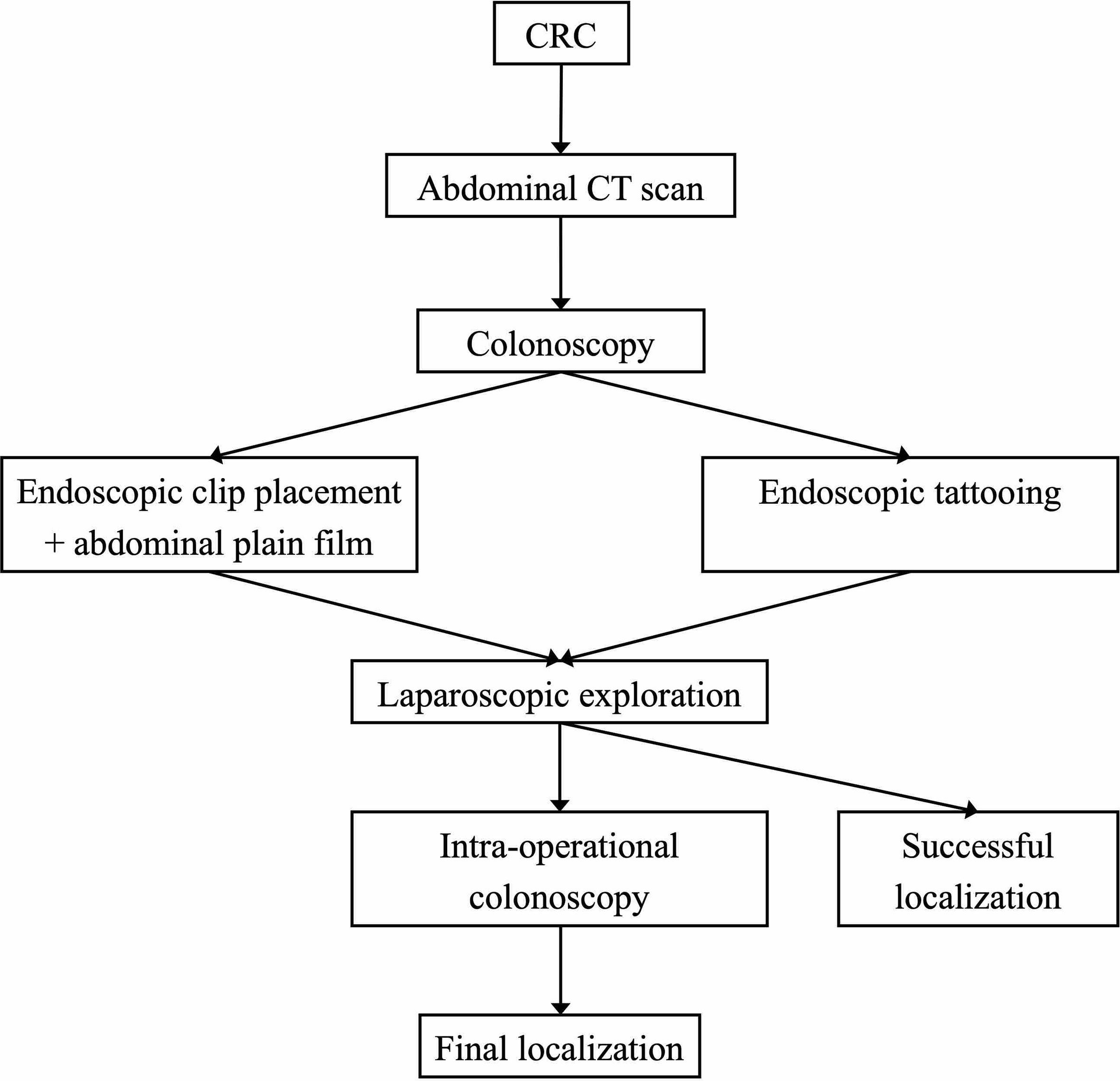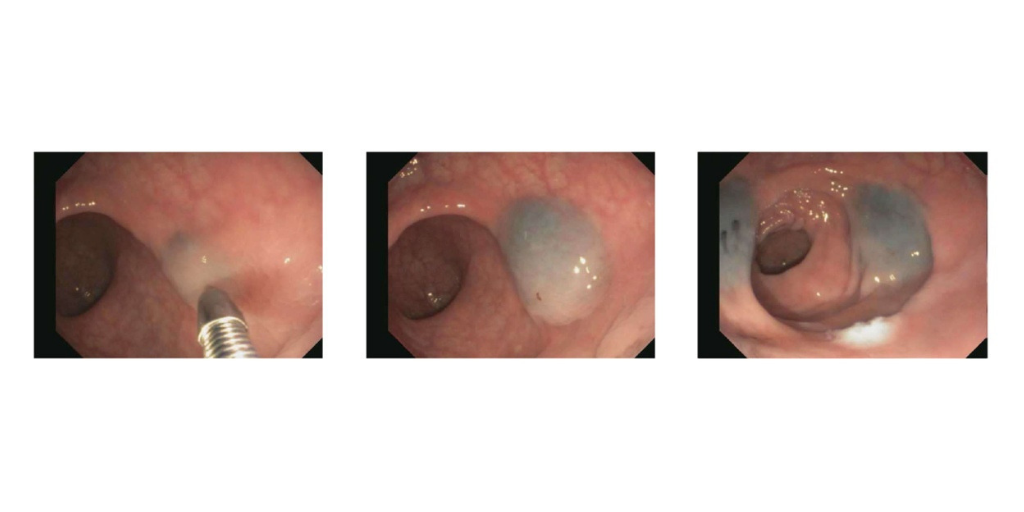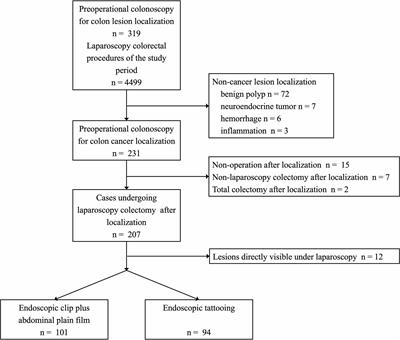Endoscopic tattooing is the gold standard for localisation of the colorectal lesions. However the endoscopist has to make a judgement as to which lesion.
The National Bowel Cancer Screening Programme guidelines advocate the use of endoscopic tattooing for suspected malignant lesions to assist in identification and facilitate laparoscopic resections.
. What protocol should be used. A definite separation between tumor and surroundings was seen using the NIR system H. 9 Endoscopic tattooing practices are variable in endoscopic units.
However the endoscopist has to make a judgement as to which lesion may be malignant and require future localisation based on the appearance and size of the polyp. A tattoo helps communicate to the surgeon where a lesion is that was identified during colonoscopy. Endoscopic tattooing ensures that a polyp can later be found easily in subsequent screenings or for surgery.
Tattoo may distort TME dissection plane and does not aid resection. The tattooing agent is delivered by an injection needle advanced through the working channel of the endoscope9The needle should be inserted at an oblique angle to the bowel wall to avoid penetrating the serosa10Transmural injection may result in diffuse staining of the peritoneal surface. Endoscopic tattooing with diluted ICG is suggested as the optimal protocol total injected dose of 05 mg at 025 mg ml injected in doses of 1 ml at two separate sites F.
Recommend tattooing at time of diag-nostic colonoscopy since properly placed tattoos are permanent and long-lasting. Endoscopic tattooing is the gold standard for localisation of the colorectal lesions. The National Bowel Cancer Screening Programme guidelines advocate the use of endoscopic tattooing for suspected malignant lesions to assist in identification and facilitate laparoscopic resections9 Endoscopic tattooing practices are variable in endoscopic units.
1 Artega-Gonzalez and team showed that surgeons save up to 40 minutes of operating room. Marking a cancer identified during a colonoscopy will help the surgeon locate and remove the cancer. Three tattoos should be placed 120 apart close to the lesion and distal to lesions proximal to the splenic flexure SpFlx.
Endoscopic tattooing with diluted ICG is suggested as the optimal protocol total injected dose of 05 mg at 025 mgml injected in doses of 1 ml at two separate sites F. Current guidelines recommend tattooing of suspicious-looking lesions at colonoscopy without a reference to the size of the polyp. Current guidelines recommend tattooing of suspicious-looking lesions at colonoscopy without a reference to the size of the polyp.
In this video Dr. The first step involves raising a submucosal bleb in the wall of the colon with 05 mL of saline followed by the injection of 5 mL of India ink into the bleb. When marking a benign colorectal lesion for resection at a later time it is best to tattoo 3 to 4 cm distal from the lesion or on the wall opposite the lesion due to the risk of perforation during EMR when the tattoo is under the lesion.
Tattooing precancerous polyps plays a very important role in colorectal surveillance and patient care. Tattooing should be strongly considered Especially important for laparoscopic resections. Colonoscopy alone is inadequate.
The physician performs flexible colonoscopy of the proximal to splenic flexure and injects a substance into the submucosa directed at specific areas through the scope while viewing the colon. The gross localization of the tumor was challenging G. In concordance with the national guidelines the st.
In 2007 a paper published in the World Journal of Surgery reported that 98 of tattooed tumors were found in surgery saving time by easily identifying harder to find lesions. The endoscopy report should designate where the tattoo is in relationship to the lesion. A denite separation between tumor and surroundings was seen using the NIR system H.
Marks hospital colonoscopic tattooing protocol stated that suspicious lesions should be tattooed with the exception of those in the caecum and within 20cmoftheanalvergethreetattoosshouldbeplaced120 apartcloseto the lesion and distal tolesions proximal tothe splenic. Tattoo Procedure Direct needle at an angle to mucosa Raise a bleb using 1-2ml of saline Swap to syringe filled with Spot or India Ink Inject 1ml into the bleb to create tattoo Swap to syringe filled with saline and flush ink out with 1ml saline. The lumen of the colon is visualized.
The gross localization of the tumor was challenging G. Proper endoscopic marking during colonoscopy procedures can be a powerful ally in the fight against colon cancer. The physician inserts the colonoscope into the anus and advances the scope as far as the splenic flexure of the colon.
Another option is to tattoo the day before anticipated laparoscopic colo-rectal resection in order to take advantage of the pre-operative bowel prep3 Based on this we recommend.

Tattoo Placement At Index Endoscopy For Patients Undergoing Elective Download Scientific Diagram

Frontiers Clip Or Tattooing A Comparative Study For Preoperative Colon Cancer Endoscopic Localization

Why When And How To Effectively Tattoo During Colonoscopy Procedures Youtube

Type Of Lesion Tattooed As Identified During Chart Review Frequency Of Download Scientific Diagram

Type Of Lesion Tattooed As Identified During Chart Review Frequency Of Download Scientific Diagram

A Quick Guide To Endoscopic Tattooing For Gi Nurses

Frontiers Clip Or Tattooing A Comparative Study For Preoperative Colon Cancer Endoscopic Localization

Gi Supply Blog Simply Smarter Gi And Endoscopy Products 3

Location Of Lesion Tattooed As Identified During Chart Review Download Scientific Diagram

To My Son Lion Bronze Pocket Watch Pocket Watch Clock Gift Pocket Watch Tattoos

Pdf Endoscopic Tattooing Of Colorectal Lesions Is It A Risk Free Procedure

22 Beautiful And Delicate Freesia Tattoo Designs Page 2 Of 2 Tattooadore Tattoos Floral Tattoo Design Daffodil Tattoo

A Gastroenterologist S Guide To Endoscopic Tattooing Methods Gi Supply


